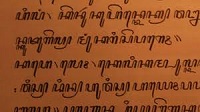
Javanese script is becoming increasingly unfamiliar to the younger generation. As a part of Indonesia’s cultural heritage, Javanese script is slowly being forgotten, especially in the era of globalization, making it less appealing to students, including those at SMP Negeri 1 Nglipar.
Students’ low interest in and understanding Javanese scripts presents a significant challenge. One contributing factor is the infrequent use of Javanese script in daily life.
Sartono, a Javanese language teacher at SMP Negeri 1 Nglipar, acknowledged this issue. He mentioned that students’ grades related to Javanese script are consistently the lowest across all subjects.
“This is because students rarely use Javanese script in their daily lives, don’t practice it often, and lack interest in the subject,” he explained.
Nuning, another Javanese language teacher at SMP Negeri 1 Nglipar, stated that the lack of engaging teaching materials lessens students’ interest in learning the Javanese script.
She mentioned that the current Javanese language curriculum at SMP Negeri 1 Nglipar relies solely on worksheets rather than textbooks.
“The materials in the worksheets are often unfinished because they are complex and difficult for students to understand,” she added.
In response to these challenges, students from Universitas Gadjah Mada (UGM) collaborated with Javanese language teachers at SMP Negeri 1 Nglipar to innovate and develop an interactive and easy-to-understand learning tool called AJAR.
This innovation incorporates augmented reality (AR) and a board game to increase students’ interest and understanding of Javanese script.
UGM students involved in developing AJAR include Davin Elian Qariru, Muhammad Fajrulfalaq Izzulfirdausyah Suryaprabandaru, Fikriansyah Ridwan Pratama, Salsabila Eka Fadila, and Veronica Tia Ningrum.
Under the guidance of Dr. Ahmad Nasikun, these students participated in the Student Creativity Program in Community Service, supported by funding from UGM and the Ministry of Education.
Davin Elian Qariru stated that the AJAR development program at SMP Negeri 1 Nglipar, Gunungkidul, aims to train Javanese language teachers to attract students’ interest and enhance their understanding through engaging and interactive learning.
“Through this collaboration, Javanese language teachers are gaining new knowledge and skills in integrating AR technology,” he said.
“Learning Javanese script through a board game makes the learning process more active and interactive,” he added.
Muhammad Fajrulfalaq Izzulfirdausyah Suryaprabandaru, another PKM team member, explained that AJAR combines AR with a card-based board game.
AR is a technology that inserts information into the virtual world and displays it in the real world through 3D visualization.
He explained that the AR animation in AJAR appears when the card is scanned with a smartphone using the Assamblr Edu app. The animation is accompanied by questions about the Javanese script, which students must answer.
“AJAR is also designed as a competitive group game where participants win by reaching the finish line after answering various questions. This, of course, encourages students’ enthusiasm and active participation through group discussions,” he explained.
All materials, questions, and learning media were tested for feasibility through discussions and consultations.
The materials and questions were based on the worksheet “Modul Pendamping Bahan Ajar Bahasa Jawa Kurikulum Merdeka,” validated by Javanese language teachers at SMP Negeri 1 Nglipar and Javanese language experts from Yogyakarta Palace, KMT Projosuwasono, and KRT Rintoisworo, certified by the Yogyakarta Cultural Office.
The AJAR materials also underwent feasibility testing by the Yogyakarta Educational Communication Technology Center, making them suitable for teaching and learning activities.
The introduction was conducted through face-to-face discussions at SMP Negeri 1 Nglipar, including a presentation on AJAR, its operation, and the AJAR manual.
It aims for Javanese language teachers at SMP Negeri 1 Nglipar to operate and independently apply the AJAR media in teaching and learning activities, thereby increasing students’ understanding and interest in Javanese script through AJAR learning media.
Teachers should be able to understand the AJAR manual after implementing the AJAR media in teaching.
To assess whether teachers can operate AJAR independently, Javanese language teachers tested its application on students during teaching activities.
“Teachers teach while assessing students’ activity levels and administering pretest-posttest questions to measure their abilities. The results show that the learning media can increase students’ engagement and understanding,” added Salsabila Eka Fadila.
Author: Agung Nugroho
Photo: Good News From Indonesia
Post-editor: Lintang

